At the beginning of January, Dirk Depoorter and Dirk Fannes go on a mission to The Gambia. Together with the local Gammol team, they want to evaluate the operation in Gambia, visit projects of the past year, prepare new projects, make agreements with local authorities and with local suppliers. Dirk Depoorter made a travelogue.
2 January 2020
Direct flight at 10.55 am, delayed by half an hour. Dirk and I arrive in Banjul, the capital of The Gambia, and are picked up by the driver of The White Horse Residence, where we will be staying in the coming days. Around 7 p.m. in the hotel.
7.30 pm: appointment with Omar, our responsible for the NGO Gammol on site. Goal: go over the agreed program for the next 5 days and adjust it according to the agreements made. And, importantly, prepare an appointment with the VDC (Village Development Committee) of Sanyang, in function of the extension of our contract (MoU: memorandum of understanding) for the use of our Gammol house in Sanyang.
3 January 2020
Village Development Committee
9 a.m. appointment with the (almost) full VDC, 11 men: confirmation of both wants to continue working together. Request from VDC to invest in Sanyang. We agree to contribute annually to the development of their territory, without focusing on certain projects. Our approach: supporting where the need is greatest, throughout The Gambia.
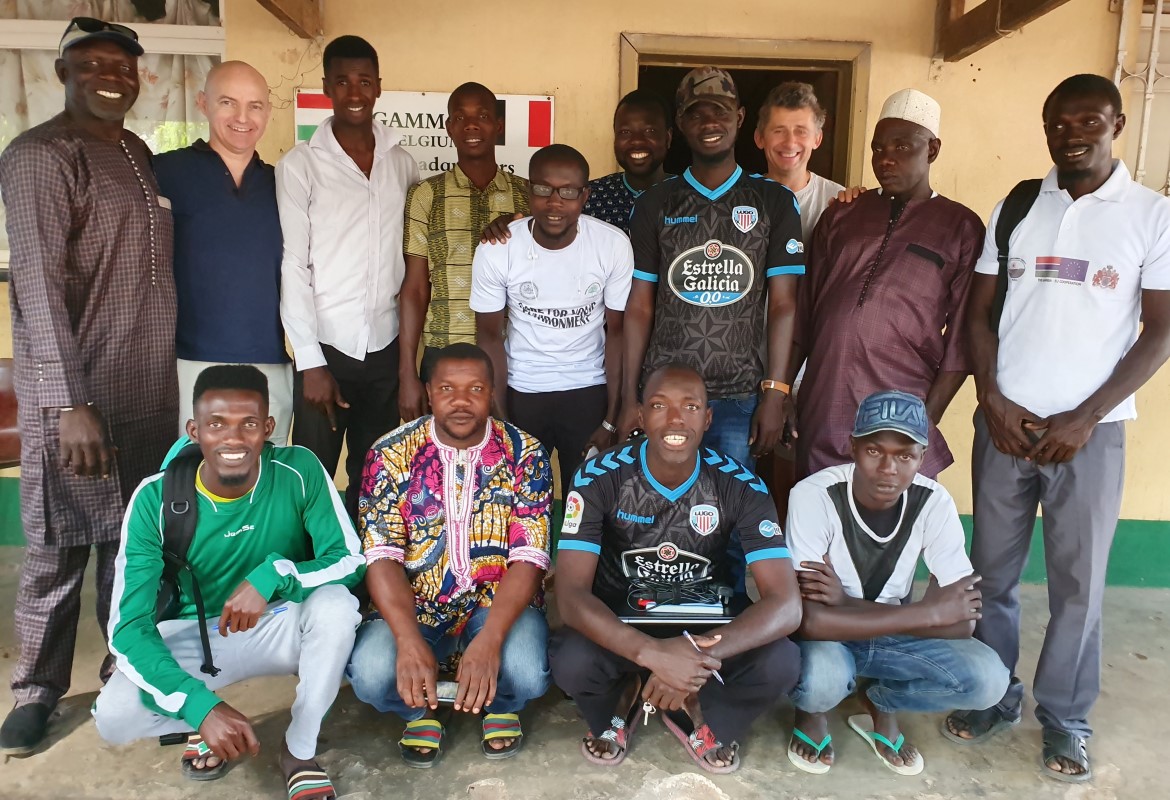
Gardens of Sanyang
Visit the garden of Sanyang from 11.30 am together with a couple of people from the VDC. It is large: 700 m. x 200 m., Divided into plots where the women grow fruit and vegetables. Problem: existing pump does not provide enough water to cover entire area. Some waiting basins are empty. As a result, women and children carry heavy buckets. Ask to help them and install additional pump(s). Later we learn that this is not necessarily the right solution.
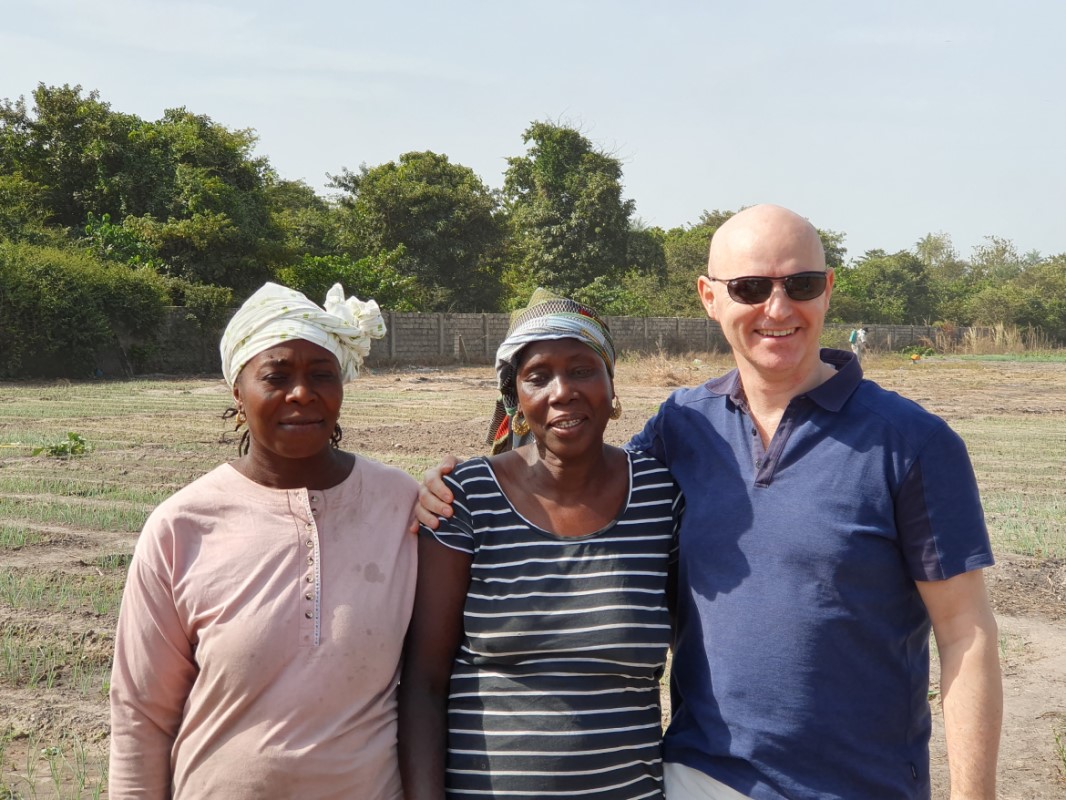
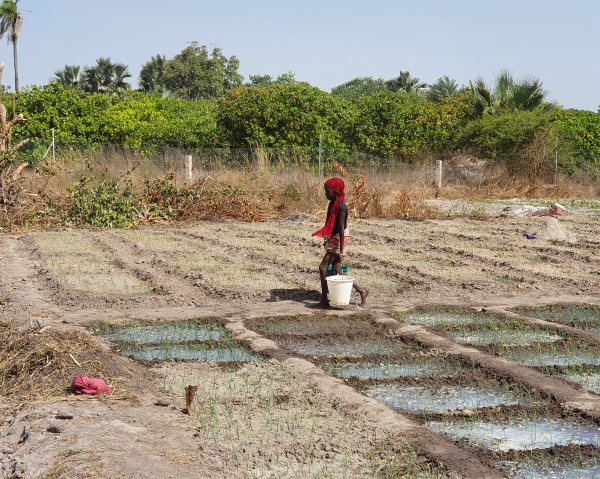
Visit to new and older installations
We visit the new installation in Fula Kunku. Our team (Omar and Lamin) did a fantastic job! They can rightly be proud of it.
Then check older installations:
- Pacholling Village: community that takes care of the installation too little. Leaking faucets and water tanks, moldy walls ... make good use of the water to irrigate their gardens. Garden is in bloom.
- Mamuda, one of our larger (higher) pump installations, installed in May 2011, with extensions. Like many pumps: too little care to keep the solar panels clean, which means insufficient power to spread water across all extensions. Some faucets are therefore dry. Or is there another reason? To be examined by turning off all taps alternately…
- In Mamuda there is also training for wound care. The nurse on site shows us his material.
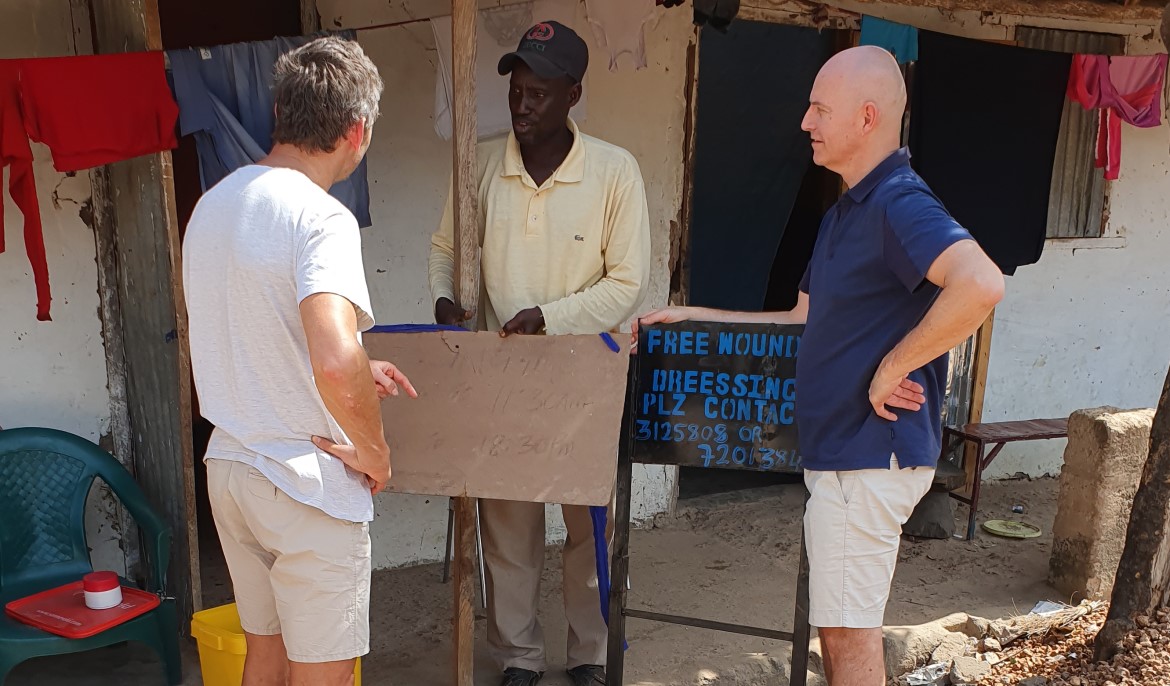
- Daru Busumbala: installation of 2012, perfectly ok, different extensions placed. Someone has been appointed who is responsible for the installation, and you notice the difference. Beautiful!
- Labakory, 2013, building completely polished. In addition, there is the old installation, where (impure) water was pumped up by hand, from the less deep water layer. A slightly more modern version than using water from the well with buckets on a pulley.
Swe Gam
In the evening we leave for Serrekunda, the largest city in The Gambia. To get there, also in this city, traffic jams, but not comparable to ours. Busy traffic, bad job, no discipline, smelly cars ... Large, dirty city, lots of dust, catches your breath.
We have an appointment with mr. Ibrahim Cole, owner of the Swe Gam company, to discuss how we can work together. He places pumps from A to Z, with material and all. We want to use his services, in part, so that our Gammol people keep their work. Our impression: serious man, former teacher, knows what he is talking about. Strict for his fellow countrymen, "they have to work harder," he says. He shows us around in his company, professionally. We are going to get involved with this.

Prepare next day
8 p.m. back at the hotel. Long productive day. Our driver, Samba, drops us off, then Omar and Lamin. Dinner, after which Dirk and I discuss the day and prepare our conversation with Omar for the next day.
4 January 2020
Tujereng
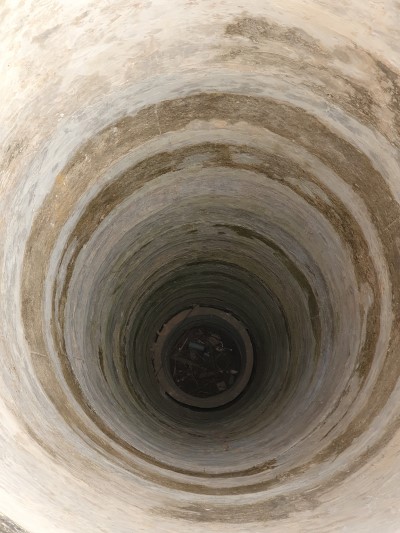 9 a.m. departure to Tujereng, where we have an appointment with the local VDC, who has applied for the installation of a water pump, for their population, about 500 people (500 means, between 300 and 700). There are no exact figures. The old well, dug by hand, is dry.
9 a.m. departure to Tujereng, where we have an appointment with the local VDC, who has applied for the installation of a water pump, for their population, about 500 people (500 means, between 300 and 700). There are no exact figures. The old well, dug by hand, is dry.
Together with someone from the VDC we visit the large community CISF Garden of Tujereng, located at the end of the village, close to the large course. Everything seems to be on place to do the same here as in the community garden of Sanyang. Pump installation, sufficient solar panels, catchment basins, central building ... but everything is dry: pump is not working, catchment basins are empty, solar panels full of dust, no garden under construction. Explanation: not yet finished ...
After Tujereng visit of a pumping station of Swe Gam, on the border of Sanyang. Clear installation of a different order: higher tower, larger vessel, pump without overflow (automatically switches off if the water vessel is full). Blooming garden around the pump.
Also in The Gambia...
On the way to the schools a few cool local advertising panels (coca cola, nescafe) ...
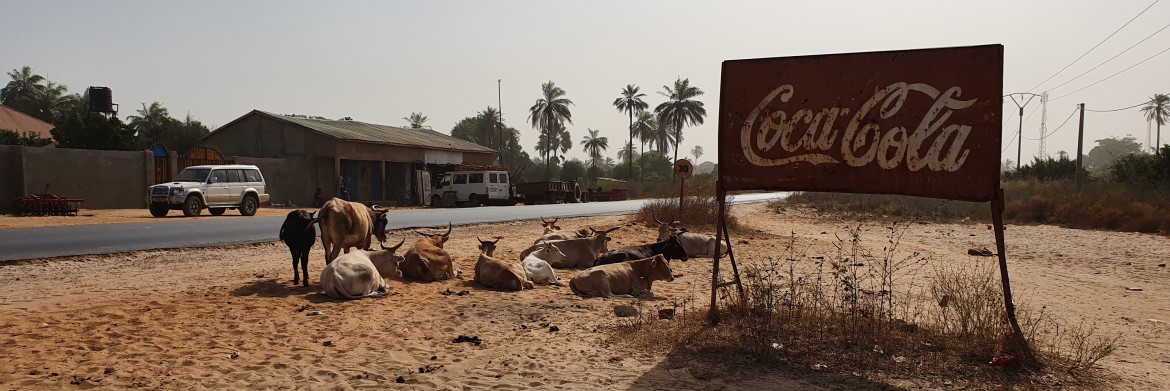
Schools of Sanyang
Schools visited in Sanyang, together with the chairman of the VDC:
- Bunkiling: 320 students, 11 teachers. Location not suitable, are building a new school in another place. Nice from far, from close you see that the construction was not always built straight. Difference with professional craftsmen. Volunteers are building here, when there is sufficient money to "continue" to build. Guestbook must! be signed ... ask for support to continue building and pump for pure water ...
- Darboekunda: 370 students, 13 teachers, building new classes. Ask fence from the school, but especially for their garden, because the animals now eat their vegetables. In addition, funds for a separate kitchen (now in 1 of their classrooms) and repair of 1 of the solar panels that was destroyed. Dirty around the school: plastic and paper. When they are asked why they do not collect all of them and clean up, they fall from the sky !? Good idea ... Have promised nothing, just like in other places, but have said that if we support, we ask responsability for the installations.
Caring and taking responsability for installations is a problem that we encounter in many places. Where the cleaning of the solar panels is a general problem. Nobody seems to know that dirty solar panels give less energy. With a few exceptions, dirty solar panels are the rule. For each installation that we visited, we had to explain to the local VDCs and managers why they should clean the panels. - Sanchaba: the third school we visit is the worst. This school is a gift from a Gambian, who has donated a part of his land so that around 120 children can follow lessons. Four teachers, led by someone who is incredibly motivated. They do not receive state aid and are therefore dependent on the spmall school fees they receive from their parents. To my question how much they earn, the answer is: teachers who teach in an accredited school receive about 5000 Dalasi per month (€ 90). As they depend on the parents, this varies between D 2000 (€ 36) and D 4000 (€ 72) per month. They got a piece of land from the same man, and their dream is to be able to build a school with 4 classes. And a garden to grow vegetables. There is a well on that piece of land, but I would not recommend it to anyone to drink water from that well (just like other old wells). Now there are 2 classes and 2 barracks in waste from corrugated iron. Not safe, torn plates that you can easily hurt yourself with. It is difficult to imagine that lessons are being given here. In addition, they also try to give their students 1 meal a day. We were impressed by the motivation of the teacher who spoke to us and by what we saw. For us a possible next project.
- Nemisack: is a larger school, where Omar (our Gambian employee) used to go. Four of their classrooms are corrugated iron barracks, without flooring. In addition, 4 other classes, brickwork, floor in tamped soil, but in much better condition than the 4 barracks. The problem is that the 4 barracks cannot be used during the rainy season: it rains in on all sides and the classes become mud classes. The result is that in that period they often have to send the students home or cram the other classes. Here too we speak with the teachers, who make their needs known. When we leave the school we see a self digged well that indicates who donated it: Sharing Wonder Int (UK), well no 100, dug by a contractor Sheriffo Sonko.
- Sanyang School: finally we visited the state school of Sanyang. This is primary education. Impressive and large, compared to the 4 previous ones. It becomes even clearer to us how essential the private nursery schools are, so that children with a basic knowledge of English can start primary education when they are 7 years old. Otherwise, they simply cannot come along and drop out prematurely. Question from this school: a water pump…
Jalambang Village
Next stop is Jalambang Village. One of the larger villages, which has applied for water installations. We are received by a large delegation, women and men. About 100 compounds, the number of residents varies considerably depending on who we ask our question to. In other villages we also usually receive different information. Reality is that they often do not know themselves. In any case: great need for water pump (s). The government has dug a number of wells not far from this village, so that their wells, which draw on the upper water layer, have dried up. Need for multiple pumps, or a heavy pump with extensions. This visit gives us a good feeling: the delegation from the village, who receives us, tells different men and women to explain to us what the needs are. We promise nothing, except that we will contact you again, via Omar.
Dimbaya Village
Last stop is the visit to our installation in Dimbaya Village. Water pump installed in May 2013. Pump no longer works and would be blocked. Omar has already tried to pull the pump out, but that was not possible. According to Omar, it would be due to the installation of another pump 400 meters away. Which seems unlikely to us. What is striking: a thick layer of dust on the solar panels. We meet the woman who normally takes care of the pump, and who has also received training in wound care. Her obvious question is to repair the pump. We first look at the other installation, and pass a hand pump, where several women are pumping water. The pump, which is supposed to be the cause of ours not functioning, is a bit further and does not work. The pump was sponsored by the Saoudi Fund for Development. And you can see it: it is a very large installation, many times larger than what we normally install, and with a battery of solar panels (all full of dust). The position where the water tank must be placed has been broken off, so that the installation is not (yet) functioning. This therefore cannot be the cause of our pump not functioning. We will try to find out the cause through Ibrahim Cole from Swe Gam.
The woman who spoke to us explains that the pump would only provide water for the other side of the village, so that our pump was definitely needed. This is remarkable, because we note that an extension has been placed from the Saudi pump to 50 m from our pump. What must be checked is whether our pump is still useful here, once the Saudi pump is working. And, if not, whether we cannot remove the pump and solar panels and recover the material.
We drive to our hotel, where we have another meeting with Omar (not the last).
